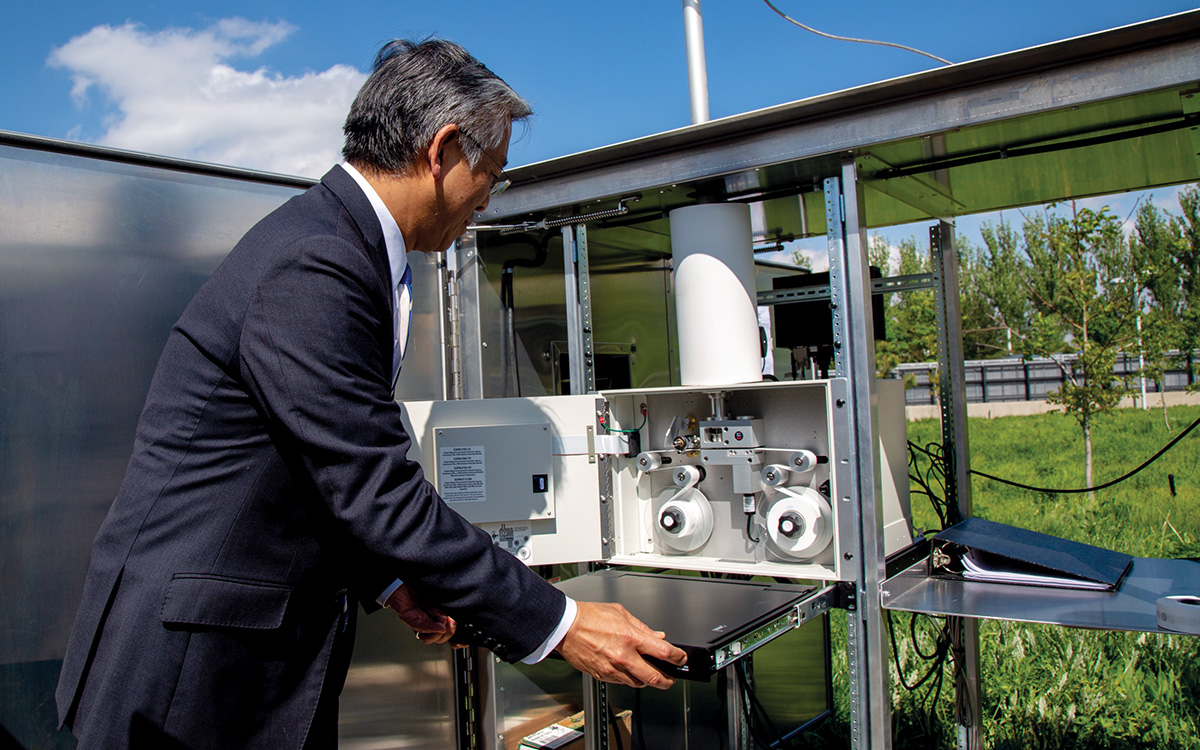Tracking Air Quality: Data for Our Community and Beyond
State’s air quality monitoring program facilitates engagement with host governments and civil society around the world.
BY MARY TRAN

U.S. Ambassador to Kyrgyzstan Donald Lu looks at Embassy Bishkek’s Air Quality Monitor in 2019.
U.S. Embassy Bishkek
Air pollution is an increasing global health threat. From wildfires across Australia and the western United States to the new visibility of the Himalayas in South Asia during the pandemic, 2020 featured drastic changes in air pollution around the world. Long-term exposure to air pollution can cause decreased lung function, lower lung capacity and development of diseases like asthma and bronchitis. More than 80 percent of U.S. embassies and consulates are in areas that exceed the U.S. Environmental Protection Agency’s (EPA) annual air quality standard for fine particles. Since 2008, the Department of State has sought to provide better ground-level data to inform the Foreign Service community, U.S. citizens abroad and the communities where they serve.
The World Health Organization and other international bodies, along with research institutions and the international media, have addressed and reported extensively on air quality. Despite the breadth and significance of the issue and growing interest in it, reliable ground-based data does not exist in many parts of the world. Recognizing this need, in 2008, U.S. Embassy Beijing installed an EPA-approved air quality monitor that provided data to U.S. personnel and citizens to reduce health risks and bolster the public’s understanding of air pollution. Other U.S. diplomatic posts in Mission China and Mission India followed suit, and all continue to provide publicly available air quality data hourly.
To help fill in data gaps elsewhere and ensure a coordinated departmentwide approach, the Greening Diplomacy Initiative (GDI) in the Office of Management Strategy and Solutions partnered with the EPA in 2015 to launch an air quality monitoring program called DOSAir. With the installation of ground-based monitors approved for regulatory use in the United States, DOSAir provides reliable, transparent data to mission personnel and the general public.
A Welcome Initiative
Since the launch of the DOSAir program in 2015 by then–Secretary of State John Kerry and former EPA Administrator Gina McCarthy, State has expanded its own network of reference-grade air quality monitors to almost 80 embassies and consulates. The monitors are made in the United States, and installed and maintained by a small American company. The technical requirements and data are all transparent and available to the public.
Because the program is transparent and underpinned both by American manufacturing and decades of EPA expertise, it has spurred productive partnerships with other countries. Marcia Bernicat, U.S. ambassador to Bangladesh from 2015 to 2018, witnessed this. “The really excellent news is, yes, overwhelmingly governments welcome our [air quality] initiative,” she said at GDI’s 10th anniversary celebration in 2020. “They trust our equipment and data.”
Countries in South and Central Asia experience some of the worst air quality in the world. The 2020 State of Global Air ranked India, Nepal, Pakistan and Bangladesh in the top 10 countries for population-weighted annual average fine particulate exposures in 2019. The report also found air pollution was the second leading risk factor for premature death in Bangladesh in 2019, an issue well known to our embassy staff and families in Dhaka. In 2016, Ambassador Bernicat and her team oversaw the installation of an air quality monitor and encouraged their partners to use and share the data.
Posts use the data to educate the public on the effects of air pollution and build demand for cleaner air.
Ambassador Alice Wells, a former senior official in the Bureau of South and Central Asian Affairs (SCA), served throughout the region and knew the importance of coordinated action. She launched an initiative to install EPA-approved monitors at all SCA posts in 2018 through SCA’s Council on Air Quality, which continues to engage with U.S. personnel and families on the topic. Wells learned that overseas personnel and their families wanted a mobile app with automated alerts to help them make decisions, such as when to jog, whether to cancel outdoor activities or whether to wear a mask. This was the genesis for the initial development of ZephAir, the department’s first air quality mobile application.
To make the data more accessible, GDI developed ZephAir with support from State’s Air Pollution Working Group and SCA. The name ZephAir is inspired by the Greek word zephyros, or “west wind.” Air quality data is now at everyone’s fingertips. ZephAir displays the EPA Air Quality Index (AQI) from the department’s monitors and from reference monitors run by some other countries. Features include the display of real-time data, 24-hour air quality trends and the daily AQI for the previous week. Users can save locations to easily track air quality in their cities of interest. They can also enable push notifications to receive alerts when AQI levels change and recommendations on how to reduce exposure to high air pollution levels and health risks.
Actionable Data
“It’s been incredible to see how important that actionable data is. It helps equip our officers, families and partners with information that helps them protect their health,” Ambassador Wells said in a 2020 GDI interview.
While the primary purpose of DOSAir is to provide air quality information to our people overseas, the monitors are also effective tools for addressing air pollution broadly, including engaging with host governments and civil society. Posts use the data to educate the public on the effects of air pollution and build demand for cleaner air. The Bureau of Oceans and International Environmental and Scientific Affairs uses the monitors in its air quality programming, which aims to increase local capacity to manage air quality and address air pollution and greenhouse gas emissions.
GDI also received support and input into app development from the Air Quality Fellows program. The program, managed by GDI, enables U.S. air quality experts, paired with embassies and consulates, to volunteer their time to facilitate research, engage with host countries and support embassies in managing air quality concerns. The fellows also provide a platform to demonstrate American solutions to air quality challenges to other countries.
“The Department of State continues to look for these opportunities to meet multiple needs with one program,” said Janice deGarmo, director of the Office of Management Strategy and Solutions. “By providing our personnel and their families with reliable data, we are able to respond to their needs. By making the data public, we are showcasing American solutions while also supporting countries in understanding the scope of the problem and how they can fix it over the long term.”
GDI will continue to develop additional features over the next year, and will incorporate additional non-U.S. government monitors, low-cost sensor data and forecasting capability from NASA in future iterations. Download ZephAir today, and visit state.gov/eco-diplomacy to learn more.
Read More...
- “The Air We Breathe: Living with Air Pollution,” by Nicole Schaefer-McDaniel, The Foreign Service Journal, October 2016
- “Breathless in Jakarta—A Cautionary Tale,” by Deborah Lynn, The Foreign Service Journal, October 2016
- “U.S. Department of State Air Quality Monitoring Program,” by Stephanie Christel, Department of State, Fall 2019



